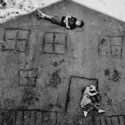 The reaction I have received to my photos of the current state of the Detroit Public Schools book depository/Roosevelt Warehouse has generally been a great outcry of "Why did this happen?" The photos found their way onto hundreds of blogs and websites, into the pages of New York and Harper's Magazine. I have seen the photos on sites written by white supremacists declaring them "a putrid example of what becomes of a city when ni--ers are empowered." I have found my photos held up on libertarian sites as examples of why taxpayers should not have to support public schools, and objectivist sites using them to launch discussions about the failures of public education. The photos, it seems, spoke for themselves: to some they said black people couldn't be trusted to govern themselves, to others that the taxes we pay for education are inevitably wasted, and that our system public education itself is a failure. And here I just thought they were beautiful.
The reaction I have received to my photos of the current state of the Detroit Public Schools book depository/Roosevelt Warehouse has generally been a great outcry of "Why did this happen?" The photos found their way onto hundreds of blogs and websites, into the pages of New York and Harper's Magazine. I have seen the photos on sites written by white supremacists declaring them "a putrid example of what becomes of a city when ni--ers are empowered." I have found my photos held up on libertarian sites as examples of why taxpayers should not have to support public schools, and objectivist sites using them to launch discussions about the failures of public education. The photos, it seems, spoke for themselves: to some they said black people couldn't be trusted to govern themselves, to others that the taxes we pay for education are inevitably wasted, and that our system public education itself is a failure. And here I just thought they were beautiful.
Reeling from the shock of seeing my photos used in this manner, I set out to answer "why did this happen?" My original inclination was, like most, to blame the school district. It seems like every slow news day here in Detroit, the Free Press rolls out another story about corruption among school administrators or schools that were shuttered throughout the city that have been vandalized, and discovered still full of supplies that could have been used by students at other schools. Teachers describe their offers to retrieve much-needed supplies from closing schools on their own time and being rebuffed by the administrators. This district is not innocent. Surely the libertarians, objectivists, and even the racists looking for evidence to support their varying Weltanschauungs can find plenty of fodder in the everyday foibles of the Detroit Public Schools without resorting to my photographs of rotting 20-year-old school supplies. This is a deeply troubled school district, and as I walked on mountains of rotting textbooks, on floors three-feet deep in shifting paper, even I could not help but think of the students, their lives, and the systemic failures of a school district crippled by both the poverty of its students and the corruption of its administrators. But still I felt compelled to find out what actually happened before I laid the blame at their feet.
The building was originally the city's main post office. A tunnel between the warehouse and the Michigan Central Station across the street shuttled mail brought in from all over the country by train. After a few decades of use, the post office moved and the Detroit Public Schools purchased the warehouse for their main depository of school supplies and records. As many as 75 to 100 people worked there at any given time. I have communicated with a woman whose father was a truck driver for the Detroit Public Schools during the 1980s; she sent me photos of a day her father brought her to work with him, delivering supplies from the warehouse to various schools. I have found distribution records that kept track of the daily delivery of food, textbooks, sporting goods, art supplies, chemicals and even elevator oil from the warehouse to schools spread throughout the 138.7 square miles of the city. I found the story of a man who was the head boiler-room engineer at the warehouse who would save any of the outdated textbooks he was instructed to incinerate and bring them home to give to his kids and grandkids, simply because he could not bear to burn a book. Good people worked for the Detroit Public Schools at this warehouse, and many wonderful people still work for the Detroit Public Schools. I know some of them personally.
On March 4, 1987, at 9:20 a.m., a fire broke out at the Roosevelt Warehouse. It spread rapidly through stacks of books on the third floor. More than 100 firefighters spent hours dousing the flames with thousands of gallons of water, but the building was effectively destroyed. At the time, school officials measured the damage at "several million dollars for the contents alone." According to Reginald Ciokajlo, then superintendent of support services, the district was lucky that most of that year's textbooks and materials had already been delivered and none of the principals had placed their orders for the next school year's textbooks. School and student records going back to 1918 were destroyed. Many books and supplies that hadn't been reduced to ash sustained fire or water damage. None of the 75 employees in the warehouse at the time of the fire were injured, though just weeks before they had complained to the fire department that exit doors had been chained and locked to prevent recurring thefts from the warehouse.
After the fire, the Detroit Public Schools abandoned the Roosevelt warehouse and eventually started storing supplies at a new location. Three years after the fire, reporters from the Free Press investigated the abandoned warehouse and discovered "boxes containing hundreds of shiny, unused textbooks." According to the Free Press, "Dust and debris covered the boxes on one loading dock at the multistory building, but inside the boxes, the books were clean. Also scattered throughout the building were unopened boxes of carbon paper, large notebook binders, erasers, index card dividers, typewriter ribbons, and other supplies, some of which appeared usable." The school district vowed to investigate the situation at the warehouse. I was unable to find any follow up to this news story. I have heard rumors that under terms of an insurance settlement, the school district was not allowed to salvage the books and supplies, but I have been unable to substantiate those rumors. My attempts to contact former administrators and superintendents were met with dead ends. What seems clear is that sometimes a system simply breaks down and fails. The distribution of textbooks and supplies is logistically complicated even under ordinary circumstances, especially for cash-strapped districts. New learning standards like those adopted under programs like No Child Left Behind can make perfectly usable textbooks obsolete. The cutting of art, music, and athletic programs can also make existing supplies unnecessary. There was undoubtedly some failure to salvage perfectly-usable materials after the fire. Who, exactly, was responsible for that failure has never been determined and s/he has never been held accountable. All that is clear now is that thousands of books were devoured by a fire; their ashes on the third floor created a polluted soil suitable for ailanthus altissima trees to grow thirty feet up through a gaping hole left by the skylights that collapsed in the heat of the flames. Books and supplies that did not burn were certainly damaged by the thousands of gallons of water that had been used to extinguish the blaze. Other books and supplies were, in 1990, apparently still usable in the eyes of one Free Press reporter. And at some point during the 1990s, the heavily-damaged building and its contents were sold "as-is" to the reclusive self-made billionaire Manuel "Matty" Moroun. I haven't been able to determine from public records when exactly Moroun took title to this property---Moroun uses holding companies to mask his real estate dealings---nor have I been able to determine who owned the property at the time of the sale. In 1997 the building went on the list kept by the City of Detroit's Buildings & Safety Engineering Department for buildings slated for demolition.
In 2000, the Detroit Public Schools privatized their supply chain. Recognizing that the existing system often created confusion over costs, inventory, and delivery, the district entered into a contract with Office Depot where each school principal would order supplies directly online. All inventory paperwork was handled by Office Depot, and the system has saved the district millions of dollars. At the time it was heralded across the nation as an example of the benefits of privatization for the supply system of one of the biggest school districts in the nation.
In 2001, the owner of the Roosevelt Warehouse obtained a permit for its demolition. In the seven years since that permit was obtained, Moroun has not taken any deliberate action to demolish the building. The building was designed by Albert Kahn and Associates, the architect responsible for most of Detroit's landmark (and now abandoned, though still extremely solid) early twentieth-century automobile factories that used the then-revolutionary technique of steel-reinforced concrete. Because of its construction, the brick and concrete Roosevelt Warehouse would be difficult and costly to take down. Moroun's company, the Detroit International Bridge Co., also owns the Michigan Central Station next door, perhaps the most solidly-built building in the city (due to reinforcements made to handle the once-constant rumbling of trains underneath it). Like the vacant automobile factories that provide a constant reminder of the industry that built and then destroyed this city, there is no real perceivable permanent use for these two buildings. Moroun is, however, more than happy to rent the train station out to Hollywood production companies looking for a preexisting post-apocalyptic set: the majestic interior and roof were most recently used for the climax of the blockbuster Transformers. According to a recent article in the Detroit News, whenever Hollywood location scouts come to Detroit, they always want to see inside the train station. One scout claimed that the building has become legendary in Hollywood.
At one point, when the train station was in far better condition, the massive Beaux-Arts masterpiece changed hands for less than $80,000. No one knows how much Moroun paid for it, but six months after he bought it, Detroit's embattled mayor Kwame Kilpatrick was making campaign promises to buy the station from Moroun and turn it into Detroit's new police headquarters. Moroun was one of several suburban businessmen who provided a much-needed last-minute influx of cash to Kilpatrick's then-failing 2005 re-election bid, allowing the mayor to fill the airwaves with not-so-subtle advertisements portraying his black opponent as the "white" "suburban" candidate (Moroun and his cronies donated at least $20,000 directly to Kilpatrick during the 2005 campaign, and have donated over $21,000 to his mother, U.S. Rep. Carolyn Cheeks Kilpatrick since 2002; in the final days of the 2005 election, the Detroit Free Press reported that Moroun and his cronies gave a further $30,000 to the mayor's PAC). It is conventional wisdom in Detroit that because of this despicable last-minute campaigning financed by white suburban businessmen, Kilpatrick was able to retain power in Detroit. Kilpatrick has since backed out of his promise to restore the station. Politics certainly play their own role in the fate of these two buildings.
Because of these contributions, Moroun will probably never receive a blight citation or be forced by the city to demolish either building, but he certainly seems content to allow nature and criminals to do the work for him. The buildings have been completely stripped of anything valuable. The windows in both are now broken or missing, hastening the effects of nature inside during Michigan's harsh winters and hot summers. No real effort is made to secure either building from trespassers. The doors stand wide open. The interiors and exteriors of both buildings are covered with graffiti. Homeless men live in both buildings. In my visits to the warehouse, I have seen people using crack and (once) a prostitute giving a man a blowjob amid the squalor. I have even heard of guys playing pickup games of ice hockey in the frozen, flooded basement of the warehouse. Last winter, a homeless man lit a barrel fire inside one of the office floors of the train station, presumably to keep warm, and dozens of fire department trucks and personnel rushed to the save a building that simply cannot burn. I doubt anyone sent Moroun the bill.
Moroun's real interest in both the train station and the book depository/Roosevelt Warehouse likely has nothing to do with the buildings themselves, but the importance of keeping the land they sit on in his real estate portfolio. Moroun owns the nearby Ambassador Bridge, one of only two privately-owned border crossings along the northern border. The bridge is a huge factor in Moroun's vast wealth: more than 25 percent of all merchandise traded between the United States and Canada crosses it, and every truck pays a hefty toll. Because of the high volume of traffic, the bridge's aging condition, and homeland security concerns, both the United States and Canada are investigating new locations for another international border crossing, including a second bridge downriver, and an old freight train tunnel under the Detroit River. The mouth of that tunnel is about 1500 feet from the Michigan Central Station and the Roosevelt Warehouse. Both sit along the road any trucks would take from a potential border crossing to the nearest highway. It must be presumed that he bought these two properties not because he has any plan to actually use them, but simply to control as much land around the proposed tunnel crossing as possible to prevent it from becoming a viable competition to his bridge. Wayne County land records indicate that during the 1990s and early 2000s, Moroun's companies bought dozens of land parcels surrounding the train station and warehouse from shell companies for $1 each. He likely owns all these properties simply to maintain his monopoly. Recognizing the inherent problems with his current bridge, Moroun (called "the troll under the bridge" by Forbes Magazine) has proposed the strangest solution imaginable: he wants to build a second bridge span alongside the first, privately-owned and operated by him (of course). Meanwhile, politicians on both sides of the border spar with each other, with neighborhood residents in the path of proposed bridges, and with Moroun, who continues to enjoy the huge financial windfall this monopoly provides.
So for seven years, Moroun's company has held a permit for the demolition of the former Detroit Public Schools book depository, but he has done nothing but neglect the building. Were the warehouse to be destroyed, like any other of the hundreds or even thousands that are torn down in Detroit every year, its bricks, its crushed concrete, rebar, and its contents would be hauled away in garbage trucks to be dumped in a landfill somewhere, covered up by more trash, and lost to us, forever. Instead, because this is Detroit, it just sits there. It is left unsecured, open to scrappers, looters, crackheads, graffiti artists, suburban taggers, vandals, prostitutes, and local bloggers. Books that once sat in boxes on shelves are now strewn about the floor in post-apocalyptic confusion. Perhaps the missing shelves were made of some metal worth hauling to the scrapyard for a few dollars that could be traded for crack. Who knows, maybe some kids just got bored one day and wanted to make a big mess. There is no longer any organization in this warehouse. There are no longer any supplies here that appear "usable" in the sense they would have been in 1990. Here, chaos will reign until it all is destroyed.
So in the end, the answer to why this happened is long and complicated. In the briefest possible terms: there was a fire, and no one knows why no one saved what could be saved, and then a man bought the building and let it rot so he could keep making billions of dollars. There is no future for these supplies or books, other than to decay and provide nourishment for the trees and plants that will eventually take over this building. What has surprised me when I've visited this site is how little things have decayed over the past twenty years. Textbooks exposed to the elements for years still smell like the textbooks you remember from school. You can still read every page. Books and paper wrapped in plastic have hardly faded. Colored chalk slowly disintegrates in rainwater, forming rivers of color along the floor. Maps of the Soviet Union remind us of how much the world has changed in twenty years, even if the plastic-wrapping around them has kept them pretty much the same. Pages from books charred in the fire flit around in gusts of wind, some of them with color photographs of children providing a glimpse into some lost moment: a smile, an exercise routine, a street somewhere that needs to be crossed.
In some ways, I must blame myself for taking these photos and holding them up as something beautiful without considering that others would use them to display the ugliness in their own hearts. But I do think that despite the ugliness that is inherent in these photos: the ugliness of poverty, the tragedy of loss, and waste, this building still lets us glimpse something beautiful. In Detroit this beauty is uniquely sustained. In other cities, buildings like this would be turned into luxury loft condominiums. They would be knocked down so that something new could be built in their place, their contents dragged off to a landfill and forgotten. Here we get to see what the world will look like when we're gone. We see that the world will indeed go on, and there is a certain beauty to nature's indifference. Someday the books will tumble from the shelves at the Bodleian and there will be no one to replace them. Someday even sooner than that, books themselves may become an anachronism, like scrolls or cuneiform tablets. It is the book lover, I think, who is most pained by these images. Even as we sit here at our computers, we pine for the feeling of pressed pulp between our fingers. We have a hard time accepting that all our words and knowledge might one day feed the trees.
[Still interested? Really? Read my original post about the book depository/Roosevelt Warehouse here]
Copyright © 2005-2016 Sweet Juniper Media, Inc.
All Rights Reserved.
All Rights Reserved.
"Sweet Juniper" is a registered trademark.
No unauthorized reuse.
No unauthorized reuse.
Categories
- Friday Morning Street Urchin Blogging ( 107 )
- Detroit ( 60 )
- SAHD ( 34 )
- photography ( 30 )
- Thursday Morning Wood ( 25 )
- Halloween ( 23 )
- Thrift ( 18 )
- abandoned places ( 18 )
- terrifying nixon-era children's books ( 16 )
- Reminiscin' ( 15 )
- Sweet Juniper Media ( 11 )
- Wendell ( 10 )
- Design ( 9 )
- San Francisco ( 9 )
- nature fights back ( 9 )
- sleep ( 9 )
- if you ain't dutch you ain't much ( 8 )
- sentimental ( 7 )
- Music ( 6 )
- Parody ( 6 )
- birth story ( 6 )
- scrappers ( 6 )
- Sweet Juniper Tunes ( 5 )
- lawyering ( 5 )
- Zoo ( 4 )
- elegant leisure ( 4 )
- language ( 3 )
- feral houses ( 2 )
- theme parks of the damned ( 2 )
- zombies ( 1 )
Archives
- November 2017 ( 2 )
- December 2016 ( 1 )
- November 2016 ( 2 )
- December 2015 ( 1 )
- November 2015 ( 2 )
- December 2014 ( 1 )
- October 2014 ( 2 )
- April 2014 ( 1 )
- December 2013 ( 2 )
- November 2013 ( 1 )
- October 2013 ( 1 )
- September 2013 ( 2 )
- July 2013 ( 2 )
- June 2013 ( 1 )
- April 2013 ( 1 )
- March 2013 ( 3 )
- February 2013 ( 1 )
- January 2013 ( 1 )
- December 2012 ( 2 )
- November 2012 ( 1 )
- October 2012 ( 4 )
- September 2012 ( 2 )
- August 2012 ( 2 )
- July 2012 ( 1 )
- June 2012 ( 3 )
- May 2012 ( 1 )
- April 2012 ( 2 )
- March 2012 ( 1 )
- February 2012 ( 2 )
- January 2012 ( 1 )
- December 2011 ( 3 )
- November 2011 ( 3 )
- October 2011 ( 5 )
- September 2011 ( 3 )
- August 2011 ( 4 )
- July 2011 ( 4 )
- June 2011 ( 2 )
- May 2011 ( 4 )
- April 2011 ( 6 )
- March 2011 ( 7 )
- February 2011 ( 4 )
- January 2011 ( 4 )
- December 2010 ( 5 )
- November 2010 ( 7 )
- October 2010 ( 5 )
- September 2010 ( 4 )
- August 2010 ( 5 )
- July 2010 ( 7 )
- June 2010 ( 5 )
- May 2010 ( 5 )
- April 2010 ( 5 )
- March 2010 ( 4 )
- February 2010 ( 5 )
- January 2010 ( 5 )
- December 2009 ( 6 )
- November 2009 ( 5 )
- October 2009 ( 8 )
- September 2009 ( 9 )
- August 2009 ( 6 )
- July 2009 ( 9 )
- June 2009 ( 8 )
- May 2009 ( 8 )
- April 2009 ( 8 )
- March 2009 ( 12 )
- February 2009 ( 11 )
- January 2009 ( 9 )
- December 2008 ( 11 )
- November 2008 ( 9 )
- October 2008 ( 14 )
- September 2008 ( 11 )
- August 2008 ( 11 )
- July 2008 ( 12 )
- June 2008 ( 10 )
- May 2008 ( 9 )
- April 2008 ( 8 )
- March 2008 ( 10 )
- February 2008 ( 15 )
- January 2008 ( 12 )
- December 2007 ( 9 )
- November 2007 ( 12 )
- October 2007 ( 11 )
- September 2007 ( 13 )
- August 2007 ( 11 )
- July 2007 ( 8 )
- June 2007 ( 12 )
- May 2007 ( 10 )
- April 2007 ( 10 )
- March 2007 ( 12 )
- February 2007 ( 14 )
- January 2007 ( 12 )
- December 2006 ( 11 )
- November 2006 ( 10 )
- October 2006 ( 13 )
- September 2006 ( 8 )
- August 2006 ( 13 )
- July 2006 ( 13 )
- June 2006 ( 15 )
- May 2006 ( 13 )
- April 2006 ( 9 )
- March 2006 ( 10 )
- February 2006 ( 3 )
- January 2006 ( 5 )
- December 2005 ( 2 )
- November 2005 ( 8 )
- October 2005 ( 4 )
- September 2005 ( 1 )
- July 2005 ( 3 )


























